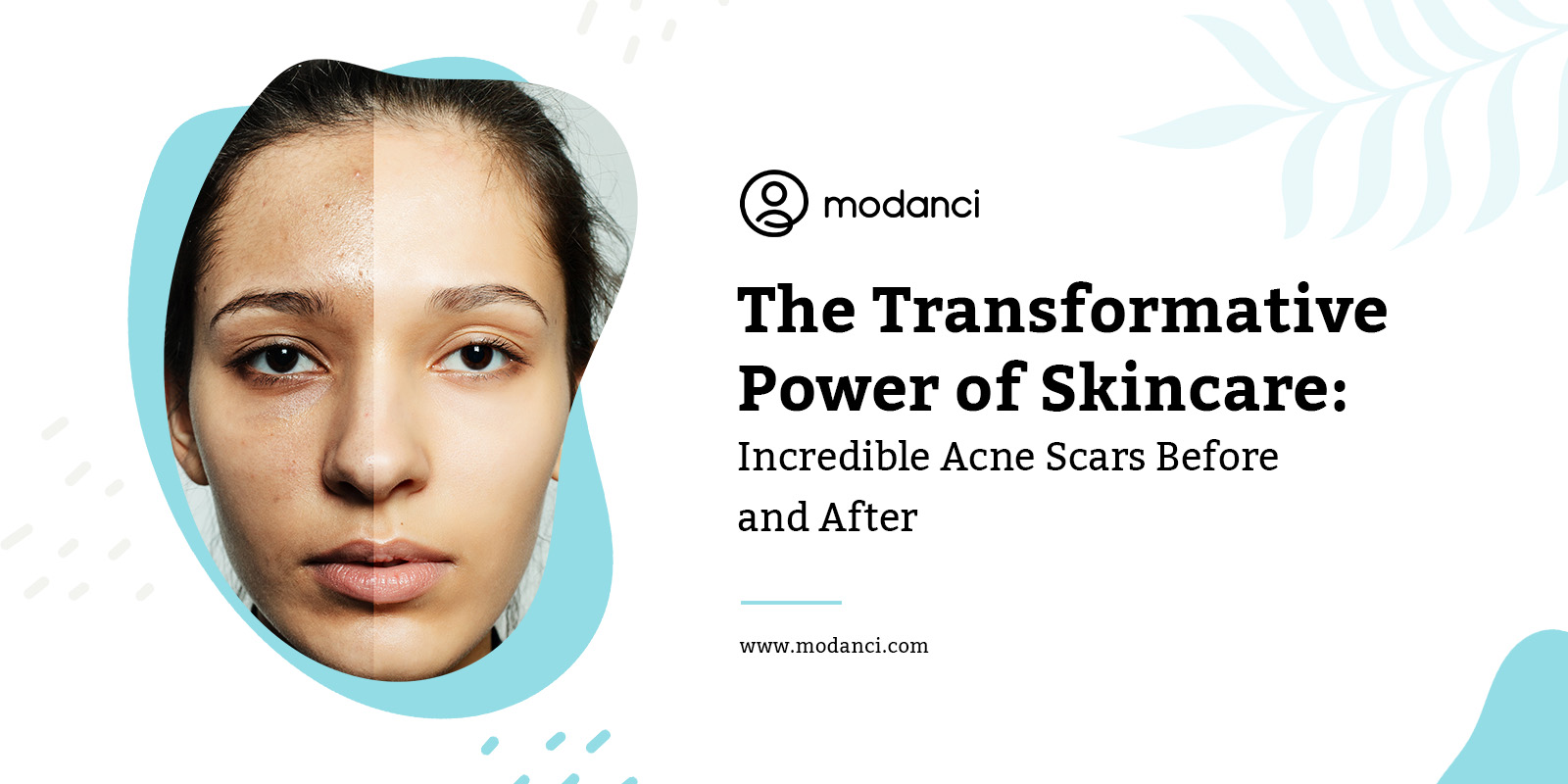Conquering acne is no easy feat, but the fight doesn’t always end there. After successfully dealing with breakouts, we often find ourselves facing a new enemy: acne scars. These scars pose a whole new challenge in our quest for flawless skin.
When pimples or cysts are popped or burst, they can leave behind lasting scars. But fear not! There are plenty of natural home remedies that can help fade acne scars and reveal fresher, smoother skin. If you have raised or pitted scars, it might be worth consulting an Ayurvedic professional for assistance. While hyper-pigmented blemishes can naturally fade away in a few months, there are ways to speed up the process.
So, keep reading to discover some effective methods for achieving that scar-free skin you’ve been dreaming of!
What are Acne Scars?
Understanding the causes of acne scars is key to treating them effectively. When acne causes inflammation, it triggers the skin’s healing process, which can result in scarring. Superficial blemishes may fade on their own, but deeper ones can leave lasting scars that need specific care. Collagen, a protein that gives skin strength and flexibility, plays a crucial role in repairing the damage after acne. The severity of scarring often corresponds to the intensity of skin inflammation.
There are two main types of acne scars: depressed and raised. Depressed scars create indentations or craters, while raised scars can be sensitive to touch and are usually permanent unless treated properly. While a good skincare routine helps manage acne, stubborn blemishes may need extra attention. It’s important to avoid harmful habits like picking or squeezing pimples, as they can worsen the damage.
Now, let’s explore some effective skincare tips and home remedies to bid farewell to acne scars!
Cleansing the Right Way
Washing your Face
Properly cleansing your face extends beyond the choice of the product; it also involves the correct washing technique. Follow these guidelines for effective face washing:
1. Before applying the cleanser, wash your hands thoroughly. This prevents the transfer of dirt and bacteria from your hands, which could clog your pores.
2. Begin by gently rinsing your face with lukewarm or cold water before applying the cleanser. This initial rinse helps prepare your skin for the cleansing process.
3. Using your fingertips, delicately massage the cleanser into your skin for 3 to 5 minutes. This gentle massage aids in the removal of impurities and promotes better absorption of the cleanser.
4. Next, rinse your face with cold water and gently pat it dry using a soft towel or washcloth. Avoid rubbing your face vigorously, as this can cause irritation.
5. Dermatologists recommend limiting face washing to twice a day, in the morning and at night. Additionally, it is advised to wash your face after perspiring heavily. If you engage in activities that cause significant sweating, such as wearing a hat or helmet, promptly cleanse your skin to prevent irritation.
By following these steps, you can ensure that your face is cleansed effectively and minimise the negative effects of perspiration on your skin.
Choosing a Cleanser
Opt for a gentle, non-soap cleanser as part of your skincare routine. Maintaining clean skin is crucial in preventing breakouts, but certain commercial cleansers can potentially cause more harm than good. Non-soap cleansers are preferable as they are devoid of chemicals that can irritate and leave scars on acne-prone skin.
Consider using an organic, chemical-free cleanser to steer clear of additional irritation and scarring. Many natural cleansers can be easily found at most pharmacies. If you have sensitive skin, avoiding astringent cleansers is advisable, as they can lead to dryness and irritation. On days when you’re short on time to rinse your face with a cleanser, opt for oil-free, non-abrasive facial wipes.
DIY Cleansers
1. Orange Peel
Utilising dried orange peel as a natural cleanser can yield excellent results. This peel is rich in vitamin C, which stimulates collagen production and aids in the repair of skin cells. Consequently, the visibility of acne scars and blemishes is diminished.
Individuals with oily skin can particularly benefit from orange peel, as it effectively eliminates excess sebum. Additionally, the essential oils present in the peel offer natural hydration for the skin.
To prepare the peel,
- Dry orange peel thoroughly and then finely grind it into a powder using a coffee grinder or food processor.
- Combine half a teaspoon (approximately 1 g) of the powder with one teaspoon (4.9 ml) of milk, coconut milk, or yoghurt.
- Gently massage this mixture onto your skin and allow it to remain for 10–15 minutes before rinsing off with cold water.
Notably, the cooling properties of milk or yoghurt contribute to inflammation reduction and the elimination of dead skin cells.
2. Milk
To supplement your natural cleansing routine, incorporating plain, full-fat milk can be beneficial for washing your face. The lactic acid in milk acts as a gentle and natural exfoliant, aiding in removing dead skin cells and promoting a more even skin tone. Additionally, it can potentially diminish scars and blemishes.
- Simply take a cotton ball and dampen it with approximately 1 tablespoon (15 mL) of milk for application.
- Massage your face in circular motions for a minimum of 3 to 5 minutes, ensuring effective cleansing of your pores and removing dirt.
If you prefer an alternative to cow’s milk, consider utilising coconut milk, which contains medium-chain fatty acids that possess antibacterial and antiviral properties. This substitution may be particularly beneficial in reducing the occurrence of pustules and cysts. Coconut milk can typically be found in the East Asian section of your local supermarket.
In the case of inflamed pimples or oily skin, you can create a mixture as follows:
- Combine one tablespoon (15 mL) of milk with a teaspoon (approximately 3 g) of rice or gram flour.
- Gently massage this mixture into your skin using your fingers.
Once complete, rinse your face with cold water and pat it dry with a soft washcloth.
DIY Exfoliators
1. Neem and Turmeric
Consider using a mask made of turmeric, neem, and honey as a potential remedy. Scientific research suggests that Neem’s natural oils hold promise in addressing acne concerns. Combining neem with turmeric and honey, known for their antimicrobial and anti-inflammatory properties, may enhance its effectiveness.
- Create a paste by blending turmeric powder, neem leaves, and honey.
- Apply the mixture to your face,
- Allow it to sit for 15-20 minutes before rinsing off.
2. Sugar
You have the option to create your own exfoliating product using sugar, which is an excellent natural ingredient for enhancing the appearance of your skin. Sugar scrubs effectively eliminate dead skin cells and rejuvenate the deeper layers of your skin by removing dirt trapped in your pores.
In addition, sugar possesses inherent anti-ageing properties that combat harmful free radicals, thereby slowing down the ageing process.
Whether you choose regular granulated sugar, brown sugar, or organic sugar, all of them can be used effectively for sugar scrubs. Among these options, brown sugar is the finest and least abrasive, while regular granulated sugar is slightly coarser but still suitable. Organic sugar is the coarsest of the three.
To create your own scrub,
- Mix ½ cup (100 g) of brown sugar with two tablespoons (30 mL) of glycerin, 1⁄3 cup (79 mL) of coconut oil, and two tablespoons (30 mL) of sweet almond oil.
- For a pleasant fragrance, you can also add a few drops of lemon or lavender essential oils.
- Combine these ingredients in a small bowl and transfer the mixture into a jar.
- To use the sugar scrub, gently massage a small amount onto the affected area for 3 to 5 minutes, then rinse it off with warm water.
Remember to store the scrub in a cool and dry place for no longer than 2 to 3 weeks.
Moisturising Right
Dry skin has the potential to irritate and exacerbate the visibility of scars and blemishes. To combat dryness and maintain a fresh complexion, it is advisable to use a non-comedogenic moisturiser. Opt for a natural and organic cream or lotion containing anti-inflammatory plant extracts such as chamomile, green tea, aloe, calendula, or oats.
Make it a habit to apply moisturiser regularly, particularly after cleansing or exfoliating your skin. Consider using a moisturiser that incorporates alpha-hydroxy acids, such as glycolic acid, lactic acid, malic acid, citric acid, or tartaric acid. These acids can aid in reducing the appearance of scars, blemishes, and wrinkles.
Natural Moisturizers
1. Aloe Vera
Aloe vera has active anti-inflammatory nutrients and promotes cellular growth and repair. This natural ingredient can be found in numerous moisturisers and is also available as a gel that can be applied topically. Consistent application of aloe vera can effectively minimise the visibility of scars.
2. Coconut Oil
Virgin coconut oil is enriched with a combination of vitamin E and fatty acids, which possess anti-inflammatory properties and combat bacteria responsible for skin infections. By applying 1 to 2 drops of coconut oil on the skin twice a day, you can effectively alleviate dryness.
Furthermore, coconut oil exhibits regenerative qualities that aid in cell repair and potentially reduce the occurrence of scars. However, individuals with oily skin should use coconut oil in moderation, limiting it to around twice a week. Excessive use of oil can clog pores and lead to additional acne breakouts.
You can find virgin, cold-pressed, and organic coconut oil at most well-stocked food stores. However, refrain from using it if you have nut allergies.
3. Honey
Honey possesses antibacterial and anti-inflammatory characteristics that can potentially enhance the appearance of scars and decrease inflammation. To utilise honey as a topical remedy, apply a thin layer onto the impacted region and cover it with a bandage.
Manuka honey contains the most concentrated beneficial compounds for scar reduction.
Honey may assist in reducing or preventing bacterial infections. It is advisable to consult with an Ayurvedic professional before employing honey for this specific purpose.
Eating Right
1. Hydrating
Maintaining proper hydration is essential for healthy skin. When your body lacks water, it can lead to dry skin and compromise your immune system’s ability to eliminate toxins through sweat and excretion. Consequently, the healing process of surface wounds, including acne scars, becomes more challenging.
Moreover, staying adequately hydrated can enhance the elasticity of your skin, thereby minimising the appearance of wrinkles and depressed acne scars. To ensure proper hydration, aim to consume a minimum of 240 mL of water every 2 hours and strive to drink at least 1.9 to 3.8 L of water per day.
If you consume caffeinated beverages, it’s recommended to drink at least 0.95 L of water for every cup (240 mL) of caffeine you consume.
2. Cutting Sugar and Dairy
Eliminating sugar and dairy products from your diet can have a significant impact on acne. The combination of sugar and dairy has been found to be particularly harmful to the sebaceous glands, which can contribute to acne development. Observations conducted among indigenous populations worldwide have revealed that their teenagers remained acne-free when they consumed traditional indigenous diets without dairy and sugar. However, upon adopting a Western-style diet, these teenagers began experiencing acne, similar to teenagers in other parts of the world.
While the effect of chocolate on acne is still not fully understood, some studies suggest that it may worsen the condition. It could be worth reducing your chocolate consumption to see if there is any improvement in your acne.
3. Vitamins and Minerals
- Vitamin E
Include Vitamin E-rich foods in your diet. Vitamin E acts as an antioxidant, safeguarding against acne triggered by bacteria, viruses, and harmful free radicals. It also provides protection against damaging ultraviolet radiation and aids in cell renewal and skin moisturisation.
Foods containing Vitamin E include vegetable oils, almonds, peanuts, hazelnuts, sunflower seeds, spinach, and broccoli.
The recommended daily intake for adults is 15 mg, although recent studies indicate that doses up to 268 mg per day are safe. Consult your doctor to determine the ideal amount for you. Incorporating Vitamin E through food sources is safe and poses no risks. However, excessive amounts of Vitamin E as a supplement can have serious health consequences.
- Vitamin C
Increase your intake of vitamin C, as it plays a vital role in boosting immunity and aiding collagen production. Vitamin C also functions as an antioxidant and supports the immune system.
To incorporate more vitamin C into your routine, you can introduce vitamin C-rich foods into your daily diet. Excellent natural sources of vitamin C include sweet red or green peppers, citrus fruits, non-concentrated citrus juices, spinach, broccoli, Brussels sprouts, strawberries, raspberries, avocados, and tomatoes.
- Vitamin A
Incorporate ample amounts of vitamin A into your diet as it offers multiple benefits for your skin. Vitamin A, also referred to as retinol, has been proven to enhance collagen production, which promotes skin health. Additionally, it serves as a protective shield against harmful free radicals and ultraviolet radiation.
To ensure an adequate intake of vitamin A, include a variety of food sources in your diet. These sources include salmon, tuna, egg yolks, carrots, green leafy vegetables, and yellow or orange fruits. These foods’ natural forms of vitamin A have no known side effects. Alternatively, vitamin A supplements are readily available at most drug stores.
It is important to note that the recommended daily dose of vitamin A ranges from 700 to 900 micrograms. However, caution should be exercised regarding high doses exceeding 3,000 micrograms, as they can lead to toxic side effects such as birth defects and depression. It is crucial to monitor your intake of vitamin A carefully.
Conclusion
In conclusion, dealing with acne scars can be frustrating, but taking preventive measures is key and following a strict skincare regime are essential. Treating your acne promptly can save you the trouble and expense of scar treatments later on.
If acne scars persist, it’s a good idea to consult an Ayurvedic doctor. They can offer personalised treatments based on your individual body constitution (Prakriti) and dosha levels. This holistic approach can effectively address acne scars and help prevent them from returning. At Modanci, we specialise in Personalized Skin Care supported by Ayurveda.
FAQs
1. What are acne scars, and how do they differ from active acne blemishes?
Acne blemishes are also known as Acne Marks. The terms acne marks and scars are often used interchangeably but it is important to make the distinction for an effective treatment. Acne marks do not cause any indentations or texture changes in the skin, but they are visually prominent, causing an uneven skin tone. On the other hand, Acne Scars have an effect on the Texture of your skin; they occur in the form of indentations and protrusions.
2. What are some common types of acne scars, and how can they be treated?
There are two main types of acne scars: depressed and raised. Depressed scars create indentations or craters, while raised scars can be sensitive to touch and are usually permanent unless treated properly. While a good skincare routine helps manage acne scars, stubborn blemishes may need extra attention. For personalised skincare solutions, visit Modanci; visit an Ayurvedic physician for medical advice.
3. Can skincare products alone effectively treat acne scars, or are additional treatments needed?
No, using skincare products alone is not an efficient way to treat acne scars. Skincare products alone are not sufficient for effectively treating acne scars. In line with the principles of Ayurveda, holistic care is essential. This involves not only using good skincare products but also maintaining a healthy diet and lifestyle. However, in cases where stubborn scars persist, it is advisable to seek guidance from an Ayurvedic physician. They can provide personalized recommendations and, if necessary, suggest appropriate medical procedures. Taking a comprehensive approach to acne scar treatment will yield the best results.
4. How long does it typically take to see visible results in acne scar reduction?
Healing acne scars requires utmost care and patience, as the timeline for improvement can vary from 1 month to a year, depending on the type of scar. Acne scars affect the skin’s texture, so consistent effort and perseverance are essential in the healing process. To accelerate this journey, you can consider personalized ayurvedic skincare solutions tailored to your specific condition. These natural remedies can provide effective and customized treatments for acne scars, helping you achieve smoother and healthier skin.
Read More:
- How to Remove Acne Scars and Reveal Radiant Skin
- Acne vs Pimples: What’s the Difference and How to Treat Them
- Clear Skin Ahead: Expert Tips and Tricks to Remove Acne from Your Face
- Acne Marks vs Scars: Understanding the Differences and How to Treat Them
- From Hormones to Diet: Common Triggers of Acne on Face




